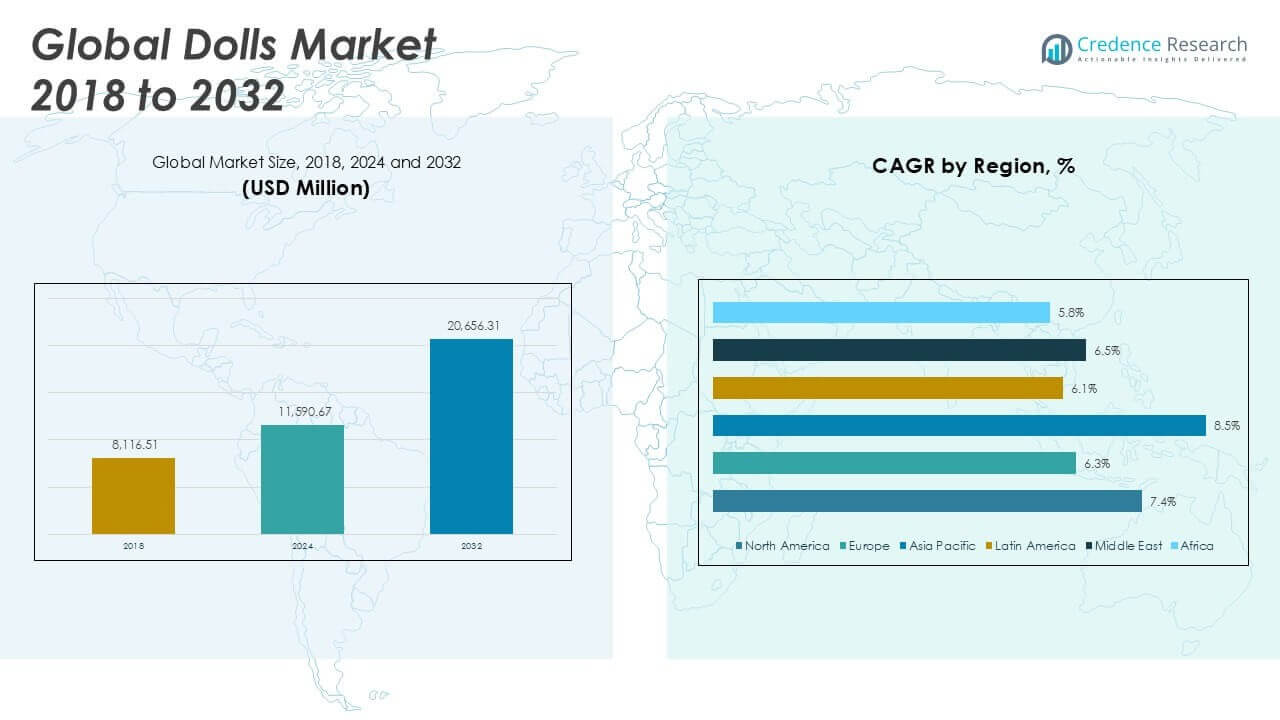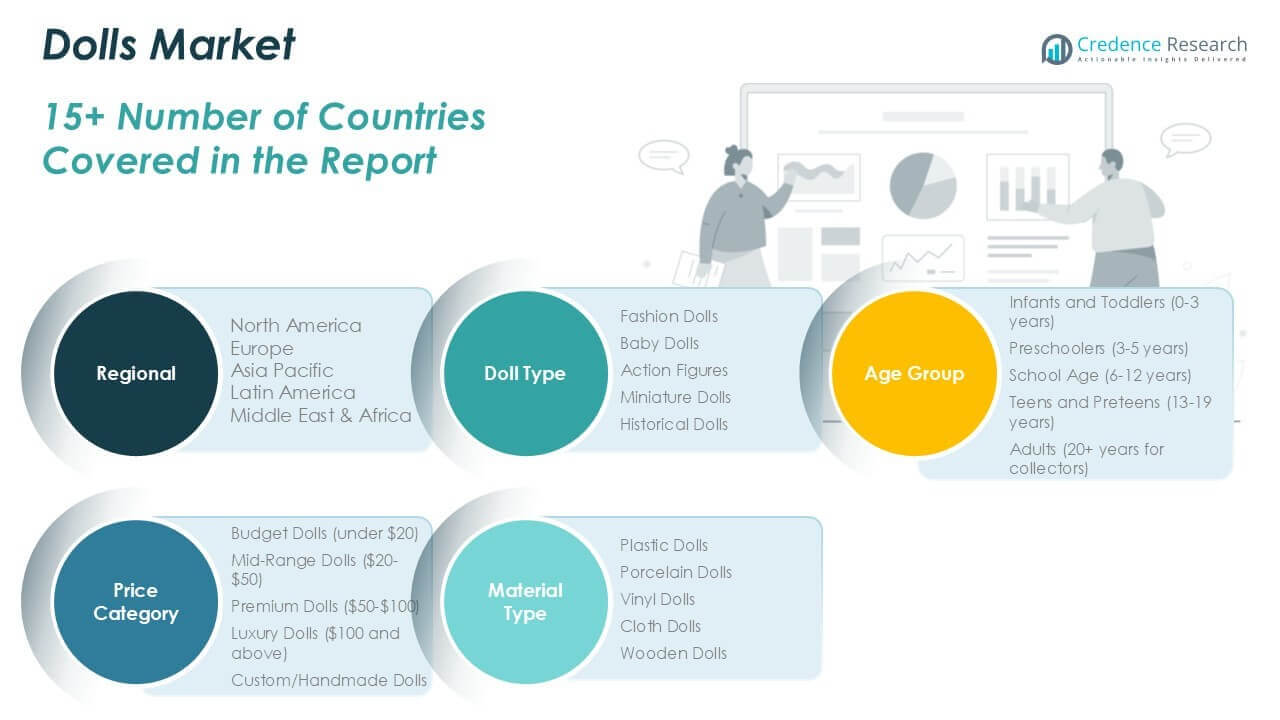CHAPTER NO. 1: GENESIS OF THE MARKET
1.1 Market Prelude – Introduction & Scope
1.2 The Big Picture – Objectives & Vision
1.3 Strategic Edge – Unique Value Proposition
1.4 Stakeholder Compass – Key Beneficiaries
CHAPTER NO. 2: EXECUTIVE LENS
2.1 Pulse of the Industry – Market Snapshot
2.2 Growth Arc – Revenue Projections (USD Billion)
2.3. Premium Insights – Based on Primary Interviews
CHAPTER NO. 3: DOLLS MARKET FORCES & INDUSTRY PULSE
3.1 Foundations of Change – Market Overview
3.2 Catalysts of Expansion – Key Market Drivers
3.2.1 Momentum Boosters – Growth Triggers
3.2.2 Innovation Fuel – Disruptive Technologies
3.3 Headwinds & Crosswinds – Market Restraints
3.3.1 Regulatory Tides – Compliance Challenges
3.3.2 Economic Frictions – Inflationary Pressures
3.4 Untapped Horizons – Growth Potential & Opportunities
3.5 Strategic Navigation – Industry Frameworks
3.5.1 Market Equilibrium – Porter’s Five Forces
3.5.2 Ecosystem Dynamics – Value Chain Analysis
3.5.3 Macro Forces – PESTEL Breakdown
3.6 Price Trend Analysis
3.6.1 Regional Price Trend
3.6.2 Price Trend by product
CHAPTER NO. 4: KEY INVESTMENT EPICENTER
4.1 Regional Goldmines – High-Growth Geographies
4.2 Product Frontiers – Lucrative Product Categories
4.3 Age Group Sweet Spots – Emerging Demand Segments
CHAPTER NO. 5: REVENUE TRAJECTORY & WEALTH MAPPING
5.1 Momentum Metrics – Forecast & Growth Curves
5.2 Regional Revenue Footprint – Market Share Insights
5.3 Segmental Wealth Flow – Dolls Type & Age Group Revenue
CHAPTER NO. 6: TRADE & COMMERCE ANALYSIS
6.1.Import Analysis by Region
6.1.1. Global Dolls Market Import Volume By Region
6.2.Export Analysis by Region
6.2.1. Global Dolls Market Export Volume By Region
CHAPTER NO. 7: COMPETITION ANALYSIS
7.1.Company Market Share Analysis
7.1.1. Global Dolls Market: Company Market Share
7.1. Global Dolls Market Company Volume Market Share
7.2. Global Dolls Market Company Revenue Market Share
7.3.Strategic Developments
7.3.1.Acquisitions & Mergers
7.3.2. New Product Launch
7.3.3. Regional Expansion
7.4. Competitive Dashboard
7.5. Company Assessment Metrics, 2024
CHAPTER NO. 8: DOLLS MARKET – BY DOLLS TYPE SEGMENT ANALYSIS
8.1.Dolls Market Overview by Dolls Type Segment
8.1.1. Dolls Market Volume Share By Dolls Type
8.1.2. Dolls Market Revenue Share By Dolls Type
8.2.Fashion Dolls
8.3. Baby Dolls
8.4. Action Figures
8.5. Miniature Dolls
8.6. Historical Dolls
CHAPTER NO. 9: DOLLS MARKET – BY AGE GROUP SEGMENT ANALYSIS
9.1.Dolls Market Overview by Age Group Segment
9.1.1. Dolls Market Volume Share By Age Group
9.1.2. Dolls Market Revenue Share By Age Group
9.2. Infants and Toddlers (0-3 years)
9.3. Preschoolers (3-5 years)
9.4. School Age (6-12 years)
9.5. Teens and Preteens (13-19 years)
9.6. Adults (20+ years for collectors)
CHAPTER NO. 10: DOLLS MARKET – BY PRICE CATEGORY SEGMENT ANALYSIS
10.1.Dolls Market Overview by Price Category Segment
10.1.1. Dolls Market Volume Share By Price Category
10.1.2. Dolls Market Revenue Share By Price Category
10.2.Budget Dolls (under $20)
10.3. Mid-Range Dolls ($20-$50)
10.4. Premium Dolls ($50-$100)
10.5. Luxury Dolls ($100 and above)
10.6. Custom/Handmade Dolls
CHAPTER NO. 11: DOLLS MARKET – BY MATERIAL TYPE SEGMENT ANALYSIS
11.1.Dolls Market Overview by Material Type Segment
11.1.1. Dolls Market Volume Share By Material Type
11.1.2. Dolls Market Revenue Share By Material Type
11.2. Plastic Dolls
11.3.Porcelain Dolls
11.4. Vinyl Dolls
11.5. Cloth Dolls
11.6. Wooden Dolls
CHAPTER NO. 12: DOLLS MARKET – REGIONAL ANALYSIS
12.1.Dolls Market Overview by Region Segment
12.1.1. Global Dolls Market Volume Share By Region
12.1.2. Global Dolls Market Revenue Share By Region
12.1.3.Regions
12.1.4.Global Dolls Market Volume By Region
12.1.5.Global Dolls Market Revenue By Region
12.1.6.Dolls Type
12.1.7.Global Dolls Market Volume By Dolls Type
12.1.8.Global Dolls Market Revenue By Dolls Type
12.1.9.Age Group
12.1.10. Global Dolls Market Volume By Age Group
12.1.11. Global Dolls Market Revenue By Age Group
12.1.12. Price Category
12.1.13. Global Dolls Market Volume By Price Category
12.1.14. Global Dolls Market Revenue By Price Category
12.1.12. Material Type
12.1.13. Global Dolls Market Volume By Material Type
12.1.14. Global Dolls Market Revenue By Material Type
CHAPTER NO. 13: NORTH AMERICA DOLLS MARKET – COUNTRY ANALYSIS
13.1.North America Dolls Market Overview by Country Segment
13.1.1.North America Dolls Market Volume Share By Region
13.1.2. North America Dolls Market Revenue Share By Region
13.2.North America
13.2.1.North America Dolls Market Volume By Country
13.2.2.North America Dolls Market Revenue By Country
13.2.3.Dolls Type
13.2.4.North America Dolls Market Volume By Dolls Type
13.2.5.North America Dolls Market Revenue By Dolls Type
13.2.6.Age Group
13.2.7.North America Dolls Market Volume By Age Group
13.2.8. North America Dolls Market Revenue By Age Group
13.2.9.Price Category
13.2.10. North America Dolls Market Volume By Price Category
13.2.11. North America Dolls Market Revenue By Price Category
13.2.12. Material Type
13.2.13. North America Dolls Market Volume By Material Type
13.2.14. North America Dolls Market Revenue By Material Type
13.3.U.S.
13.4.Canada
13.5.Mexico
CHAPTER NO. 14: EUROPE DOLLS MARKET – COUNTRY ANALYSIS
14.1. Europe Dolls Market Overview by Country Segment
14.1.1. Europe Dolls Market Volume Share By Region
14.1.2. Europe Dolls Market Revenue Share By Region
14.2.Europe
14.2.1.Europe Dolls Market Volume By Country
14.2.2.Europe Dolls Market Revenue By Country
14.2.3.Dolls Type
14.2.4.Europe Dolls Market Volume By Dolls Type
14.2.5.Europe Dolls Market Revenue By Dolls Type
14.2.6.Age Group
14.2.7. Europe Dolls Market Volume By Age Group
14.2.8. Europe Dolls Market Revenue By Age Group
14.2.9.Price Category
14.2.10. Europe Dolls Market Volume By Price Category
14.2.11. Europe Dolls Market Revenue By Price Category
14.2.12.Material Type
14.2.13. Europe Dolls Market Volume By Material Type
14.2.14. Europe Dolls Market Revenue By Material Type
14.3.UK
14.4.France
14.5.Germany
14.6.Italy
14.7.Spain
14.8.Russia
14.9. Rest of Europe
CHAPTER NO. 15: ASIA PACIFIC DOLLS MARKET – COUNTRY ANALYSIS
15.1.Asia Pacific Dolls Market Overview by Country Segment
15.1.1.Asia Pacific Dolls Market Volume Share By Region
15.1.2.Asia Pacific Dolls Market Revenue Share By Region
15.2.Asia Pacific
15.2.1. Asia Pacific Dolls Market Volume By Country
15.2.2.Asia Pacific Dolls Market Revenue By Country
15.2.3.Dolls Type
15.2.4.Asia Pacific Dolls Market Volume By Dolls Type
15.2.5.Asia Pacific Dolls Market Revenue By Dolls Type
15.2.6.Age Group
15.2.7.Asia Pacific Dolls Market Volume By Age Group
15.2.8.Asia Pacific Dolls Market Revenue By Age Group
15.2.9.Price Category
15.2.10. Asia Pacific Dolls Market Volume By Price Category
15.2.11. Asia Pacific Dolls Market Revenue By Price Category
15.2.12. Material Type
15.2.13. Asia Pacific Dolls Market Volume By Material Type
15.2.14. Asia Pacific Dolls Market Revenue By Material Type
15.3.China
15.4.Japan
15.5.South Korea
15.6.India
15.7.Australia
15.8.Southeast Asia
15.9. Rest of Asia Pacific
CHAPTER NO. 16: LATIN AMERICA DOLLS MARKET – COUNTRY ANALYSIS
16.1.Latin America Dolls Market Overview by Country Segment
16.1.1.Latin America Dolls Market Volume Share By Region
16.1.2.Latin America Dolls Market Revenue Share By Region
16.2. Latin America
16.2.1. Latin America Dolls Market Volume By Country
16.2.2.Latin America Dolls Market Revenue By Country
16.2.3.Dolls Type
16.2.4. Latin America Dolls Market Volume By Dolls Type
16.2.5. Latin America Dolls Market Revenue By Dolls Type
16.2.6.Age Group
16.2.7.Latin America Dolls Market Volume By Age Group
16.2.8.Latin America Dolls Market Revenue By Age Group
16.2.9.Price Category
16.2.10. Latin America Dolls Market Volume By Price Category
16.2.11. Latin America Dolls Market Revenue By Price Category
16.2.12. Material Type
16.2.13. Latin America Dolls Market Volume By Material Type
16.2.14. Latin America Dolls Market Revenue By Material Type
16.3.Brazil
16.4.Argentina
16.5.Rest of Latin America
CHAPTER NO. 17: MIDDLE EAST DOLLS MARKET – COUNTRY ANALYSIS
17.1.Middle East Dolls Market Overview by Country Segment
17.1.1.Middle East Dolls Market Volume Share By Region
17.1.2. Middle East Dolls Market Revenue Share By Region
17.2.Middle East
17.2.1. Middle East Dolls Market Volume By Country
17.2.2.Middle East Dolls Market Revenue By Country
17.2.3.Dolls Type
17.2.4.Middle East Dolls Market Volume By Dolls Type
17.2.5.Middle East Dolls Market Revenue By Dolls Type
17.2.6.Age Group
17.2.7.Middle East Dolls Market Volume By Age Group
17.2.8.Middle East Dolls Market Revenue By Age Group
17.2.9. Price Category
17.2.10. Middle East Dolls Market Volume By Price Category
17.2.11. Middle East Dolls Market Revenue By Price Category
17.2.12. Material Type
17.2.13. Middle East Dolls Market Volume By Material Type
17.2.14. Middle East Dolls Market Revenue By Material Type
17.3.GCC Countries
17.4. Israel
17.5. Turkey
17.6.Rest of Middle East
CHAPTER NO. 18: AFRICA DOLLS MARKET – COUNTRY ANALYSIS
18.1. Africa Dolls Market Overview by Country Segment
18.1.1.Africa Dolls Market Volume Share By Region
18.1.2. Africa Dolls Market Revenue Share By Region
18.2. Africa
18.2.1.Africa Dolls Market Volume By Country
18.2.2.Africa Dolls Market Revenue By Country
18.2.3.Dolls Type
18.2.4.Africa Dolls Market Volume By Dolls Type
18.2.5.Africa Dolls Market Revenue By Dolls Type
18.2.6.Age Group
18.2.7. Africa Dolls Market Volume By Age Group
18.2.8. Africa Dolls Market Revenue By Age Group
18.2.9.Price Category
18.2.10. Africa Dolls Market Volume By Price Category
18.2.11. Africa Dolls Market Revenue By Price Category
18.2.12. Material Type
18.2.13. Africa Dolls Market Volume By Material Type
18.2.14. Africa Dolls Market Revenue By Material Type
18.3. South Africa
18.4.Egypt
18.5.Rest of Africa
CHAPTER NO. 19: COMPANY PROFILES
19.1. Mattel
19.1.1.Company Overview
19.1.2.Product Portfolio
19.1.3.Financial Overview
19.1.4.Recent Developments
19.1.5.Growth Strategy
19.1.6.SWOT Analysis
19.2. MGA Entertainment
19.3. Hasbro
19.4. Disney
19.5. Madame Alexander
19.6.Jakks Pacific
19.7. LEGO
19.8.Bandai
19.9. HABA
19.10.Maison Battat
19.11. Miniland
19.12. Melissa & Doug
19.13. Tru Kids
19.14. Lammily
19.15. Winarea









